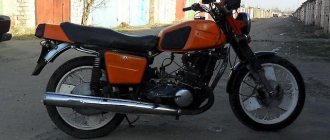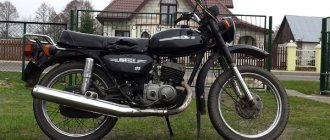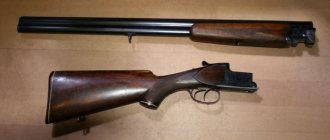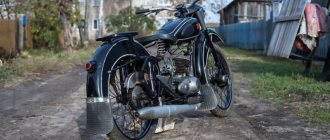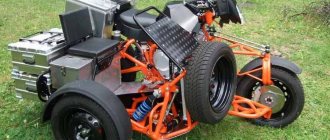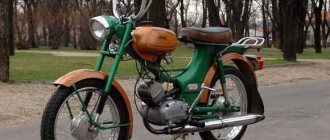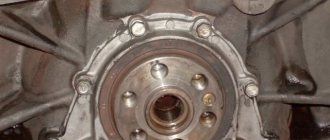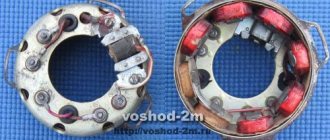In 1983, the Kavrovsky plant launched the modernized Voskhod 3M motorcycle. The purpose of the modernization was to improve the operational and technical characteristics of the Voskhod motorcycle. The platform for creating the motorcycle was the Voskhod 2M model. Since the early 90s, serial production of the Voskhod 3M 01 modification began. But still, many owners of this device are not satisfied with the appearance. Therefore, in this article we will talk about tuning sunrise 3m.
Technical characteristics sunrise 3m.
| Name | Index |
| General indicators | |
| Load limit, kg | 165 |
| Dry weight, kg | 125 |
| Number of gears | 4 |
| Dimensions | |
| Distance between wheels/width/height from ground to seat, mm | 2000/ 761/ 1090 |
| Ground clearance, m | 1,25 |
| Turning radius, m | 2,5 |
| Performance indicators | |
| Maximum acceleration, km/year | 105 |
| Gasoline consumption per 100 km | 4.4 l |
| Engine | |
| Type | Two-stroke, single-cylinder, carburetor |
| Volume | 173,7 |
| Power at 5500 - 5800 rpm | 4 l. s./ 10 kW |
| Clutch | Multi-disc in oil bath |
| Cooling system | Air |
| Electronics | |
| Voltage | 12 V |
| Ignition system | Electronic, contactless |
| Alternator | 65 W |
| Chassis | |
| Frame | Tubular, welded, single |
| Wheels | Spoked, tube tires, 3.25 - 16 inches |
| Brake mechanism | Drum with mechanical drive |
| Suspension | |
| Front | Telescopic, wheel travel 160 mm |
| Rear | Pendulum, wheel travel 80 mm |
Motorcycle improvement
Boosting the engine The Voskhod motorcycle has not been produced for a long time, but it does not lose popularity in our time. This is due to the low cost of Soviet equipment. But the old technology has several disadvantages: low power indicators, outdated design. Therefore, in order to get a high-speed and modern means of transportation from an old motorcycle, drivers carry out tuning of the sunrise 3m with their own hands.
Moto-Kovrov
The upgraded motorcycle received new 12-volt electrical equipment. The generator power was 65 W, which ensured reliable engine starting and good operation of the motorcycle's lighting and alarm systems in all engine operating modes.
All connections in electrical equipment were made using plug connectors enclosed in plastic blocks - they provided a more reliable connection and prevented the ingress of moisture and dirt.
To make it easier to control electrical devices on the motorcycle, new switches were used. On the left of the control panel there was a button for turning on the direction indicators, a horn button and a high-low headlight switch; the right remote control had an emergency engine shutdown key and a day-night switch; it was also the body of the coil-type throttle control handle . The sound signal had a sound pressure level of 105-110 decibels and was located under the headlight on a special bracket. The new relay ensured uninterrupted operation of the direction indicators.
The use of “European Beam” type optics with asymmetric light distribution in the new headlight housing ensured excellent visibility in low and high beam.
Above the headlight there was an instrument panel, the body of which was made of aluminum alloy until 1985, and since 1986 the modified body has become plastic.
The panel housed a speedometer, an ignition switch and two indicator lamps. A blue lamp indicated the inclusion of high beams, an orange lamp indicated the direction indicators. The instrument panel was protected from vibration by rubber bushings. The motorcycle also used a front brake signal switch, which was located in the front brake lever bracket. The new high steering wheel reduced driver fatigue during long trips. The use of new shapes, with thickenings at the ends of the clutch and front brake control levers, made it possible to reduce the risk of injury and stress on the driver’s hands while driving.
Completely new shaped handles on the steering wheel were made of black rubber. Modern rear-view mirrors in round plastic cases, on high racks, were screwed into new brackets for the clutch and front brake levers.
Rubber casings (corrugations) were introduced into the design of the front fork instead of steel cups, which provided reliable protection against moisture and dirt getting on the surface of the fork parts, and also reduced the cost of the product, reduced weight, and the motorcycle began to look more modern. Reflectors were installed in the aluminum headlight brackets. Curly rubber rings protected the headlight brackets from vibration. An anti-theft device was installed on the lower cross-arm of the fork, locked with a separate key. The front shield was height-adjustable (two positions), the fastening of which moved to the upper part of the movable fork pipes.
The first batches of motorcycles were equipped with a middle closure from the previous model, then a short, (without trunk) middle closure was used, which was painted in the color of the motorcycle or covered with chrome.
The front and rear mud flaps were made using new technologies using rollers rather than a stamp, as was the case before. A rubber mudguard and a new rear light bracket were installed on the rear shield. The frame featured folding driver's footrests with new rubber bands. The changes affected the rear suspension pendulum. The rear brake reaction support bracket was located at the bottom of the left stay, closer to the axis of the pendulum. In order to ensure the reliability of the brake mechanism assembly, as well as to prevent extraneous sound when using the rear brakes, jet thrust was used. The rear sprocket was now placed in a plastic housing consisting of two halves. The wheel hubs have a different appearance.
The base of the front and rear brakes, as well as the decorative plate of the front wheel, were painted matte black.
The muffler has acquired a more modern appearance. The new muffler plug was secured with two screws.
The fuel tank was changed, it became narrower and taller, but the capacity remained the same.
The main changes in the engine of the Voskhod-3M motorcycle affected the upper head of the connecting rod: instead of a bronze bushing, a needle bearing was used, which increased the durability of the crank mechanism. The Kickstarter of the new motorcycle was installed with a folding foot.
When painting motorcycles, the plant used a wide (as possible) color gamut of paint and varnish material, and there is no point in listing what colors the Voskhod-3M motorcycle was painted in.
To save money, at the end of production of the Voskhod-3M motorcycles, the lever brackets and the steering wheel mount were painted matte black.
The "Voskhod-3M" motorcycle was the base model for the small-scale production of the "Voskhod-3M Tourist" motorcycles,
"Voskhod-3M Sport",
"Voskhod-3M Lux"
and "Voskhod-3M Hunter",
as well as the production of the next model “Voskhod-3M-01”.
The set of tools remained the same, but a motorcycle first aid kit was not provided.
During the production of the Voskhod-3M motorcycle, 204 bearings from the People's Republic of Bulgaria, PAL spark plugs and spark plugs, and JIKOV-2928SE Czechoslovakia carburetors were used.
Additionally, the motorcycle was equipped with: a windshield, roll bars, side and rear luggage racks and a towbar for “Raccoon” and “Pony” motorcycle trailers.
The plastic windshield was secured with four screws. Two to the chrome brackets, which, in turn, were screwed with telescopic fork plugs, and two screws to the headlight mounts.
The safety bars were made from a pipe with a diameter of 28 mm. U-shaped, chrome-plated arches had mounting brackets in the upper and lower parts for one M8 bolt. The brackets were pulled together at the top through a U-shaped bracket welded to the front frame strut, and at the bottom the brackets were attached together with the engine.
It was possible to install a towing device on the motorcycle for the use of a motorcycle trailer, which was attached to the passenger's footpegs and to the place where the rear shield was attached, or a trunk with side shelves, or a trunk without shelves that were attached to the passenger's footpegs and to the place where the saddle was attached.
In 1983, the assembly of Voskhod-3M motorcycles was established in Syria. From the Degtyarevsky plant, motorcycles were delivered disassembled to the outskirts of Damascus, where an enterprise was organized to assemble 2-3 thousand motorcycles per year. Subsequently, the production of frames and painting of all parts was established. Motorcycles were sold in 75 stores across the country with full service until the end of the 80s, and then production was curtailed.
In 1983, at the Design-83 review-competition, the Voskhod-3M motorcycle was awarded a Diploma and a bronze medal from VDNKh. Factory workers were awarded for the development of the motorcycle. V.A. Degtyareva: silver medal from VDNKh Evgeniy Vasilievich Bychkov, bronze medals from VDNH Yuri Vladimirovich Danilov, Yuri Dmitrievich Vvedensky, Vladimir Pavlovich Pechenov.
The motorcycle was awarded a quality mark. In the year of the 40th anniversary of the Victory over Nazi Germany, a motorcycle rally was organized.
The Voskhod-3M motorcycle rolled off the assembly line from 1983 to 1993. Its production exceeded one and a half million (1,535,226 units), which was a record for motorcycle production at the plant named after. V.A. Degtyarev for all the years.
During the period 1984-1985. Working on the main assembly line, I had the opportunity to participate in the assembly of orange Voskhod-3M motorcycles.
A well-preserved Voskhod-3M motorcycle can be viewed in Nikolai Tubaev’s private museum “Moto-Kovrov”.
Parts of the cylinder-piston group
Tuning sunrise 3m begins with improving performance characteristics. The maximum speed of the Voskhod 3M motorcycle can be increased by lightening the CPG parts. To do this, we use a milling machine to bore those places that do not affect the strength.
We lighten the connecting rod in the same way. To play it safe, you can find foreign analogues. Next, you need to bore the purge, inlet and outlet channels. This is done in order to better mix and ignite the air-fuel mixture.
Advantages of the model
Despite its inconspicuous appearance, the Voskhod 2 motorcycle, a photo of which can be found in any advertisement for the sale of Soviet equipment, has significant advantages:
- Motorcycles rarely broke down (exceptions include improper use by many drivers);
- Very low gasoline consumption when driving around the city, as well as over rough terrain;
- Now, as before, you can always find missing parts if you start repairing a motorcycle or replacing spare parts;
- Good combination of engine power and volume;
- The fuel tank is enough for 500–600 km of non-stop travel;
- The cost of the motorcycle is low, which is also an advantage;
- Using inexpensive brands of gasoline when riding a Voskhod 2 motorcycle will allow you to save a decent amount;
- Good braking system.
Supply system
To make the bike go faster, you need to adjust the original carburetor for a higher fuel supply or replace it with a more efficient one. To install a new carburetor, you need to perform the following steps:
- we grind aluminum bushings under the flange of the pipe attaching the carburetor to the cylinders;
- cut off the edge of the inlet channel;
- take a flange from an old carburetor;
- We fasten all the elements using cold welding.
The assembled carburetor must line up exactly with the intake port.
Tuning options
Refinement of the design involves internal or external tuning. During internal modifications, the engine is rebuilt, driving parameters, suspension, and brakes are optimized. When external modifications are made, the motor vehicle is given a sporty style or it is converted into a chopper.
Features of internal tuning
Owners often rework the Voskhod-3M engine. To increase engine thrust, the factory paper air filter is replaced with foam filter elements. This helps reduce air exhaust friction. Then the jets and diffusers are polished using an abrasive material, the diameter of which affects the volume of fuel entering the engine.
To improve the fuel exhaust system, a new modernized carburetor is installed. From the existing pipe, take flanges for mounting on the cylinders, grind out aluminum bushings, and cut off the flange from the exhaust pipe. In an old carburetor, take a second flange. Using cold welding, the parts are connected.
The design is adjusted until it fits perfectly into the exhaust channels. Internal gaps are filled using epoxy glue.
Often rear adjustable shock absorbers are installed and sports tires are installed. When performing such tuning, the motorcycle becomes more aggressive and sporty.
Performing external tuning
In a sporty style
With a low seating position and a high front fork, there is a desire to modify the motorcycle in accordance with the sporty style. To do this, raise the rear shock absorbers and replace the exhaust pipe elbow. This way the exhaust pipe is level with the rear axle. Exhaust pipes with a larger diameter will improve the design and increase the traction of the bike.
External modifications can include painting, chrome plating, installation of nickel-plated arches instead of the old factory protection, installation of large rear-view mirrors, stepped seats and wheel tuning.
At the end of the tuning, a sports fairing is installed.
Chopper
When performing tuning for a chopper, shortened rear shock absorbers are cut off or purchased. Thanks to this replacement, the rear of the motorcycle will be lowered by several centimeters. The rear fork and wheel are replaced with wider ones. The angle of inclination of the front fork axis is replaced, and the cylinder covers are equipped with chrome plated cups. The same style is followed when tuning the headlights, rear lights, and dashboard.
Tuning for Cafe-bike
With such a modification, to reduce costs, they weld the rear part of the frame with their own hands, shorten the fork, trim and adjust other parts. For the steering wheel and seat, your own strength may also be sufficient. A headlight with a brake light is installed from trucks.
Most owners can carry out tuning on their own using only purchased parts due to the simplicity of the designs and the low cost of spare parts.
Reed valve
A design feature of a two-stroke engine is that during the working stroke of the piston, part of the working mixture exits through the outlet window. In order for the air-fuel mixture to be completely burned, a reed valve must be installed. Along with fuel economy, it increases traction characteristics at low speeds, which improves acceleration dynamics.
Modern look
Along with the increase in power characteristics, there is a need to improve the appearance of the unit: installing a new panel, nickel-plated arches, fairings. One of the popular options for tuning a 3m sunrise among drivers is to convert the sunrise to a cross.
The advantages of this option are that the cross bike moves well off-road, is easy to control and does not require fundamental design changes.
Cross version of the motorcycle.
A few simple instructions on how to convey sunrise, tuning for cross.
- When creating a cross bike, wheels play a very important role, since they take the main load. The wheels should be able to absorb strong impacts well. Spoke-based wheels can handle this task. You should select a tire based on the following dimensions: 120/70-17 at the front and 160/60-17 at the rear.
- The front suspension meets more stringent requirements. Unfortunately, a compromise solution is not possible here, since the original fork may not withstand the load. You will have to buy a fork from a motocross bike as a kit.
- The rear suspension is being converted to a single shock absorber. For this purpose, the fork needs to be welded or selected to the required size at a motor disassembly shop. The spring for the shock absorber is selected based on the weight of the bike and the driver. Next, the suspension is adjusted so that the rear wheel travel does not exceed 250 mm.
Previous entry Tuning IZH Jupiter-5 - do it yourself
Next entry Ural motorcycle - valve adjustment
